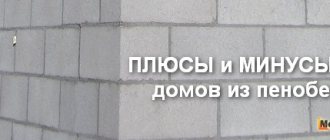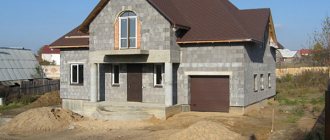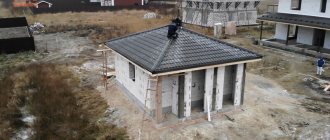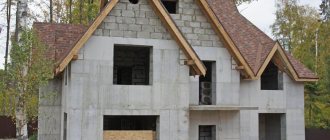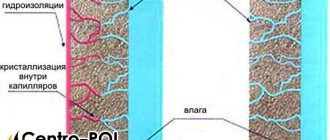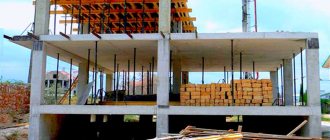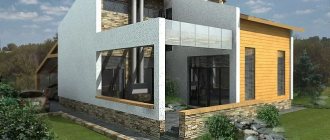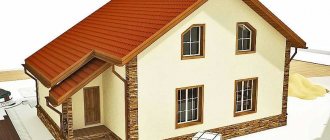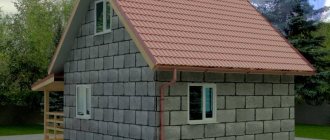Reviews from owners of houses made of foam blocks. Characteristics and design features. How foam block behaves over the years. What is better: foam block or gas block.
When choosing a house made of foam blocks, you need to know the reviews of the owners first. To learn about other people's mistakes and not step on similar mistakes. This article will tell you in detail about the advantages and disadvantages of foam concrete structures. All the nuances of construction and pitfalls when building a house made of foam concrete. What needs to be done to ensure that a foam concrete building lasts a long time with a minimum list of problem situations and a minimum of costs.
What is better: foam block or gas block. Combined designs. What are the sizes of foam concrete blocks?
Sergey
Do you think it is necessary or not to build a house from foam blocks? Read the reviews we have collected from the owners of such houses and make your choice. At the end, the pros and cons of houses made of foam blocks are considered.
Foam blocks have become increasingly used. According to marketers, they have many advantages: they weigh little, have large dimensions, which has a positive effect on the speed of construction, an attractive price, and good thermal insulation characteristics. Is it really? Who to trust: sellers, or those who already live in a house made of foam blocks? To give a complete answer to the question, we analyzed reviews from real owners who built a block house and live in it. If you can't decide whether to build or not, check them out.
We have a two-story house made of foam blocks. The advantage of the material is ease of cutting and fast construction speed, minimal shrinkage. The main thing during construction is to choose a reliable company. If you build it yourself, you must strictly adhere to the technology.
Improper construction will affect your future living: cracks will appear, the material will deteriorate faster due to excessive exposure to moisture. Make a high-quality foundation, insulation and use special cement-based glue when laying blocks. Then everything will be fine.
Negative reviews
“I have never seen a material worse than foam concrete. Its strength is zero - with an ordinary door key you can make a hole in the wall without much effort. I very much regretted that I built a house out of it. I think that in 15 years it will lose its shape and begin to crumble on the sides. You can't hang anything heavy on it; the iron doors will fall out after a year of use. The same applies to bookshelves and window bars.
Sometimes they write that such things should have been thought out in advance, during the design, but what to do if you want to make a rearrangement during your stay? The outside must be covered with a special protective layer, and if this is not done, cracks will appear throughout the house. Plastering the outside must be done with a very high-quality and expensive solution so that there is normal adhesion, and this greatly increases the cost of the house.
And another important point. We came across a material made in violation of the manufacturing technology, as the windows constantly fog up, the corners easily chip, and the walls crack. In general, not a house, but some kind of house of cards.”
“Personally, I don’t recommend making a house out of foam blocks for one simple reason: this material is constantly being counterfeited. Moreover, they are counterfeited so shoddily that a third of the material may fall apart on the way from the store to the construction site.
If this happens, consider yourself lucky, as you can return such material to the seller. What if this happens after you start living? In general, I’ll give you good advice: low-quality foam blocks are covered with light and dark spots. If you see one like this, run away from him.
In general, it is difficult for a non-specialist to buy normal material; it is easy to be deceived. It’s better not to take risks and not to believe that houses made of foam blocks, reviews of which from the owners characterize them as the best in the world, are as beautiful as they are cheap.”
Alexander, owner of a house made of foam blocks
I decided to build a house from foam blocks for several reasons. Well, first of all, affordable price. The savings became noticeable even at the moment of erecting the foundation. Secondly, the speed of construction. The walls grew “by leaps and bounds.” Laying is done in the same way as in the case of brick, there is no shrinkage. To make your blocks fit better, moisten them with water. These are not all the advantages of such houses. Who is thinking whether to build or not to build, the answer is - build if you want to save on everything: time, money, nerves, and so on.
Counting the number of foam concrete blocks for building a house
To accurately calculate the need for foam blocks for the construction of a building, you must have the following data:
- general square footage of the walls, including partitions;
- total area of openings (windows, doors, etc.);
- dimensions of PBB purchased for construction;
- wall thickness, which determines the masonry method.
The peculiarity of foam concrete blocks is that they all have different sizes. It depends on the manufacturer of building materials. The most common types are 600 × 300 × 100 mm, 600 × 300 × 200 mm, 600 × 400 × 200 mm. The first type of blocks is designed for the construction of walls inside a building.
External walls are most often laid on a bed or foam block. In the first case, their thickness will be 300 mm (if 600 × 300 × 200 mm blocks are used) or 400 mm (for 600 × 400 × 200 mm blocks). In the second option (laying with a spoon), the walls have a thickness of 200 mm. In Russia, the walls of houses, as a rule, are no thinner than 300 mm (taking into account our climatic conditions).
For internal partitions, as mentioned above, foam blocks 600 × 300 × 100 mm are usually used and placed on spoons. In this case, the thickness of the interior walls is no more than 100 mm.
To find out how many foam concrete blocks are needed, two calculation methods are used:
- with a mortar joint (has a thickness of 5 mm);
- excluding the seam.
Let's give an example of how to calculate the number of foam concrete blocks for building a house.
Let's say we are given the task of erecting a building with an area of 10 × 7 m2 and walls 3 meters high. In the external walls you need to make 1 opening for the entrance door (90 × 200 mm) and 3 openings for windows (130 × 150 mm each). There are no internal partitions in the house. For masonry walls, the thickness of which will reach 300 mm, foam blocks 600 × 300 × 200 mm (plus 5 mm for the mortar joint) were purchased.
Let's calculate all the necessary parameters in order:
- Perimeter of external walls: (10 + 7) ×2 = 34 m.
- The total square footage of all the walls of the house: 34 × 3 = 102 m2.
- Total area of all openings: (0.9 ×2) + (1.3 × 1.5) × 3 = 7.65 m2.
- Net dimensions of walls without openings: 102 - 7.65 = 94.35 m2.
Area of the outer part of the PBB: 0.6 × 0.2 = 0.12 m2 without mortar joint; (0.6 + 0.005) × (0.2 + 0.005) = 0.125 m2 with a seam, that is, 5 mm was added on each side.
To find out the amount of block building materials, the total square footage of the walls is divided by the area of the outer part of the block: 94.35 ÷ 0.12 ≈ 787 pcs. (without mortar joint); 94.35 ÷ 0.125 ≈ 755 pcs. (with seam).
It turns out that the second calculation method is more economical for as many as 32 foam blocks. In both cases, a reserve 2% is added to the result obtained for possible defects and damage to building materials during transportation to the destination or installation.
Now it is much easier to calculate the consumption of foam concrete using online services. Typically, specialized websites offer electronic calculators for free calculation of PBB.
Having entered the initial parameters, the user immediately receives the result. What you need to specify for the calculation:
- length, height, thickness of walls;
- dimensions and number of openings (doors and windows);
- type of foam blocks used (dimensions).
In addition to the consumption of building materials, convenient online services calculate many parameters. This may be the volumetric mass of the PBB, the number of containers (in this case, pallets) required for transportation, etc.
Svetlana
I don’t know much about construction, so when choosing a material for a house, I proceeded from the main thing: reliability, durability, speed of building a house (I want to quickly move to a new place). I didn’t want to listen to the sellers, since everyone understands that the main thing for them is to sell. I had to independently search for the necessary material from the relevant literature. After comparing several building materials, I decided to focus on foam concrete. It suited my requirements perfectly.
Now I live and everything is fine. The main thing is to contact a trusted company with good builders who have the necessary education. Be sure to require documents that confirm the qualifications of the workers.
Concrete blocks - pros and cons
concrete blocks are used in almost every suburban construction
. Naturally, the most common materials are wood and brick. However, wood is far from the strongest and most durable material, and brick is quite expensive, and it takes a long time to build from it. In addition, you will need a lot of such material, and that’s all money. But, there is another option - concrete blocks. They practically do not have these disadvantages. Low-rise houses made of concrete blocks are especially popular today. They are distinguished by excellent strength, fire resistance, sound insulation and good appearance.
Vladimir, pensioner
Since I lived in the city all my life, in my old age I wanted to move to live outside the city. He saved enough money to build his own house and buy a plot of land. I didn’t dare to build a house from foam blocks with my own hands, after all, I’m not the same age. Instead, I turned to a well-known company in our city. We agreed with them on building a house from foam blocks, since this is one of the most inexpensive options.
I resisted for a long time, because I thought it was better to give preference to wood. It “breathes” and looks nicer in appearance. However, as it turned out, foam blocks are not inferior to wood in their parameters. And in terms of reliability and durability, they are even superior if the construction technology is followed. And the speed of construction is absolutely fantastic, an excellent option for those who have no time to wait.
Advantages of foam concrete
Dear reader, having heard from us a variety of horrors and problems associated with foam concrete, I would probably like to ask. What does this material even do in the modern construction market? And how do knowledgeable people decide to build housing from such?
In fact, not everything is as bad as it might seem at first glance. In addition to its many disadvantages, foam concrete also has undeniable advantages, which have allowed it to firmly gain a foothold among other wall products. Judge for yourself.
Cheapness
In order to produce foam concrete, you do not need to set up serious production and invest millions. Sometimes all the equipment fits in a regular garage. And the starting materials are the most common and inexpensive. Sand, cement, water and foaming agent. As a conclusion, the product itself is much cheaper than its enclave counterpart. Moreover, if desired, the developer can even make wall material for himself with his own hands.
Reviews from home owners and builders
Yulia, Nizhny Novgorod
“In our village, most of the cottages are made of foam blocks - apparently, the contractor agreed with some factory. The buildings are already 12 years old, and the whole family has been living here almost since their completion. It’s hot in the house in winter, although our boiler is already acting up, and the gas pressure often drops. But the walls, in my opinion, hold the accumulated heat well, slowly releasing it at night, and this is definitely a plus. Regarding “breathing easily” - you can’t say that, there’s nothing to compare with. But there are definitely no unpleasant odors or stuffiness.”
Sergey, Samara
“I don’t like the fact that in a block house you can’t mount anything heavy on the wall. I even had to fork out money for a floor-standing boiler, because it was scary to hang a regular 120-liter boiler on foam blocks. But running the wiring through a groove or hammering in a nail is no problem. If you are planning to build, plan in advance where you will have what you will have, and embed the metal profile directly into the masonry.”
Vitaly, Ufa
“We built a block house with a custom-made attic. A clear design, a good foundation with a grillage, high-quality glue - and the result was excellent housing, which has been actively used for 7 years. We recently toured our properties and visited these owners. No cracks or leaning walls. According to reviews from residents of houses made of foam blocks, there is no dampness either. We also received an order from them to update the plaster on the facade, and at the same time we looked at everything. The corners have crumbled a little - they have broken off along with the layers of cladding, but otherwise the blocks look good.”
Polina, Krasnodar.
“At one time we were very disappointed with foam blocks. They wanted to save money, but not at the expense of environmental friendliness, so they were chosen. And then it turned out that they were not so warm after all. In the first winter, a lot of money was spent on heating, and the second floor had to be completely closed. In the spring, my husband himself removed all the siding from the outside and covered the walls with mineral wool. Only after this did the house become warm in winter, and we reopened the upper rooms.”
Valentin, Moscow region
“To the lady who left the previous review: judging by your place of residence, the foam blocks under the siding alone could not have been enough for warmth. This option is only suitable for southern winters. But either your contractors cheated, or you yourself saved extra money, since there is no insulation. I also have a foam block house. But, firstly, the masonry is one and a half, and secondly, there is mineral wool and a curtain wall on the outside. Heating costs are minimal, absolutely environmentally friendly, and there are no damp corners anywhere - I live as if I were in a log house, but I don’t need to caulk.”
Victor (Moscow region)
I offer my know-how. Maybe someone knows this trick, but I figured it out myself. I was going to build a house with my own hands. I have some experience and assistants too. I read a lot of reviews about foam concrete. They write in different ways. But, in the village, half of the houses are foam concrete. So I settled on it.
One thing that confused me was that if the screws don’t stay in the block, how to install the doors and windows? They fall out.
The decision came unexpectedly. The blocks intended for laying the outer wall were sawn worse than the blocks of the inner row, due to their greater density. So we decided to install denser blocks along the contour. So what if their thermal conductivity is lower, there will still be plaster inside. Everything is holding up great. And in order to really hang shelves, you have to keep a supply of special dowels.
Stepan (Tula region)
Why did we decide to build a house from foam concrete?
- The savings became noticeable even at the stage of pouring the foundation.
- The blocks were produced near the site - they were delivered free of charge. We have a suburban plot in the village of Malaya Dubna (Orekhovo-Zuevsky district, Moscow region) next to the manufacturer Penoblok.Ru.
- The geometry of the foam blocks is decent. We used special glue. At first glance, they overpaid, but the seams are thin, beautiful, and tight.
- The walls grew “by leaps and bounds”; we did not expect such a speed.
- The windows were installed immediately upon completion of the work.
We were frightened by the shrinkage of the house, but either the metal corners did their job, or the foundation did not let us down, or the house settled evenly, but no cracks appeared. True, it doesn’t look very presentable, but we haven’t gotten to the exterior decoration yet. In general, after 4 years of operation, there are no complaints.
Material consumption for masonry
Foam blocks, the sizes and prices of which are indicated below, according to reviews from home owners, allow for quick laying - you can build a full-fledged house in a season.
To estimate material consumption for different module sizes, you can look at the tabular data:
| Foam block, dimensions, cm | Quantity per 1 m² of masonry, pcs. | Quantity per 1 m³, pcs. | Quantity on pallet, pcs. | Foam concrete - price per block (D600), r |
| 60x30x10 | 16.7 | 55.0 | 80.0 | From 70.00 |
| 60x30x12 | 13.8 | 46.0 | 64.0 | From 80.00 |
| 60x30x15 | 11.2 | 37.0 | 48.0 | From 95.00 |
| 60x30x20 | 8.4 | 27.0 | 40 | From 125.00 |
| 60x30x25 | 6.7 | 22.0 | 32 | From 165.00 |
| 60x20x40 | 4.8 | 20.83 | 30 | From 170.00 |
Note: the presented data is relevant when the horizontal support platform of the modules is 60 cm in length, 30 cm in width, which corresponds to the thickness of the wall.
Saburov brothers
We built a house made of foam concrete in the Rostov region. Summer here is warm but rainy, so over time we are going to cover the house with plaster. For now, to prevent it from picking up moisture, they covered it with a water-repellent agent. I asked the construction company and they recommended Antipluviol S Mapei. Expensive, in Rostov we have 5,200 for 5 liters.
I bought Ceresit ST 13 (2,150 for 10 liters). The walls don't darken, which means they don't draw water. The cracks have not increased over the 7 years of residence. And those that exist are clearly caused by the shrinkage of the foundation; the house did not stand up properly, they were in a hurry to build walls. As I understand it, the foam block, despite being lightweight, requires a good foundation. It's a pity that it came late. But finishing will improve the situation.
Why is aerated concrete bad for building a private house?
House made of aerated concrete.
To evaluate the features of building a house or cottage from this material, you need to understand what problems you will have to face. The most important aspects:
- For external and load-bearing walls, foam concrete with a density of 600 kg per cubic meter should be used. m. But its thermal insulation performance is not very high. Ideally, lay out two rows: the outer one from a more durable one, and the inner one from a loose one, then the house will be warm, but this will greatly increase the costs and labor costs of construction.
- A block 37.5 cm thick is enough for reliable thermal insulation in the middle zone. But in fact, it turns out that the walls on the outside need to be additionally insulated with foam plastic or mineral wool, which means extra money and a considerable amount of work.
- Even if the technology is followed to the smallest detail, after a few years cracks appear on approximately 20% of the blocks due to deformation occurring due to shrinkage of the foundation. The problem can be solved by pouring a monolithic foundation, but its price is several times higher than with a standard strip foundation.
- The surface must be plastered, even if insulation is not required. If left for several years, damage will occur due to freezing of moisture in the outer pores.
- Without a good primer, the surface strongly absorbs moisture. Conventional plasters do not adhere well to aerated concrete; you need to use special ones, which are more expensive.
If you calculate the correct wall thickness or initially rely on façade insulation, you can compensate for the shortcomings. It is also worthwhile, no later than 1-2 years, when the initial shrinkage has passed, to cover the surface with a reinforcing mesh and plaster it to hide small cracks.
Nikita (Samara)
Before construction began, I read about the porosity of the foam block and that the fasteners do not hold well. Everyone advises using special fasteners. I thought this problem wasn’t worth a damn. It turned out to be in vain. How it came to interior work - at least shoot yourself.
While the water heater was hung up, they came up with so many devices so that it would stay in the wall and not fall on its head. Special dowels do not hold the heavy structure. We ordered furniture for the kitchen without any hanging units at all, only pencil cases and base cabinets. And it seems like this, small things, fasteners. Both the foam blocks are from the manufacturer and the construction technology is followed, but they are not insured against fragility in the walls.
Interesting Facts
Medieval barbarism with foam blocks
Some say that the use of natural materials is a step back in development. They say that if you follow this, you need to move into caves and throw away your mobile phone. But let's take a closer look at what the modern construction industry is and what, for example, modern cellular concrete is made from, and even more so, foam concrete.
Frankly, we were shocked by what the composition of the foam concrete was previously. It turned out that to make it, a foaming agent should be added to the cement dough. In aerated concrete, this is a chemical reaction of aluminum oxide and hydrogen peroxide, and in the case of foam concrete, foam was the “fluffing agent”. But the most disgusting thing is that the foam is made from feathers, bones, horns, hooves and other things, and also from blood from which the moisture has been evaporated. Yes, blood from the slaughterhouse is mixed into the foam concrete.
For this reason, there are companies that make foam concrete blocks not from pig blood, so as not to offend the feelings of believers. But what about vegetarians, for example, or simply people who are disgusted by the knowledge that they live in a house where the walls are literally soaked in blood or extracts from the flesh of other living beings? Naturally, advertising will never show the back side of a product until you yourself start looking for all the ins and outs.
Foam concrete - what is it?
So, foam concrete belongs to the group of cellular concrete, and it is often confused with aerated concrete, which will differ in composition and final processing technology (it can be autoclaved or non-autoclaved). The basis of the material is cement, sand and water. Manufacturing technology was virtually unused in the 1930s. Additives are added to the cement solution to form foam (they can be organic, as we have already mentioned, or synthetic). Additives begin to foam the mass of the solution, saturating it with air bubbles and increasing its volume.
The bubbles begin to distribute throughout the mixture, and during the hardening process they leave closed-type cavities (cells). Such pores will reduce the density of the material - in addition to lightness, concrete receives other useful qualities for construction. Since a cementitious binder is used for the production process of cellular concrete, its strength will begin to increase for a long time after creation (as tests have shown, the strength will increase 4 times after 30 years of operation).
Production technology
There are different types of concrete for construction. The production of the material does not require building complex technological chains, and the cement-sand mixture is placed in a mixing container, where additives in the form of foam in a water solution are supplied from a foam generator.
Occasionally, VSM fiber (construction micro-reinforcing fiber) is used as an additive, which increases the strength of the material or dry ash (i.e. fly ash), which makes it possible to save cement. Mixing of the initial components will take place under pressure, and then the mixture is cast into special molds (cassettes) or as a monolith. Otherwise, after drying, the mass will be cut according to the required parameters. Excess water will evaporate when dried. Hardening occurs naturally, which will reduce the homogeneity of the structure with small cells (compared to aerated concrete). The simplicity of the process makes it possible to prepare foam concrete on the construction site. The material will be cheap because production will require 2 to 4 times less cement.
Mikhail (Leningrad region)
I have been living in a foam concrete house for almost 12 years. Like any material, foam concrete has its disadvantages. For example, here and there there are cracks in the block itself, and there are a couple of cracked seams. But they are not critical and are probably caused by the fact that they used a mesh with a wire diameter of 2 mm for reinforcement, but it was necessary to take reinforcement of at least 6-8 mm. At that time, I didn’t want to bother with scoring the block, now we’re paying the price. But the house is warm, compared to our neighbors who live in insulated brick houses, ours, even not plastered, simply retains heat perfectly.
By the way, the walls are built in two rows. The first is made from a load-bearing (I don’t know the correct name) foam block of the D 800 brand, the second is from a thermal insulating D 400. And yes, the dowels hold in it perfectly, the main thing is to take it longer so that they can reach the second layer. In general, there are no complaints about the foam block house. The main thing is not to be lazy and study the technology both for those who build it themselves and for those who order the work (so that they can control it). And of course, follow it during the construction process.
Problems with foam concrete and how to deal with them
But today we decided not to talk about common truths, but still study a house made of foam concrete. It's better to know its pros and cons. Frankly speaking, there have been quite a few complaints about this material. Let’s try to systematize them a little, and at the same time tell you what to do so that such questions do not arise.
The walls are cracking
The most common problem with cellular concrete is high cracking. If you look at another private house, it’s not even two years old, but a web of cracks has already crawled along the walls.
This is especially true for areas under window sills. It is for this reason that many people complain about the quality of the foam material and even threaten to destroy a country house made from it with one hammer.
Yes, there is nowhere to put the truth. Foam blocks, just like aerated concrete, have very poor tensile strength, and therefore, at the slightest violation of masonry technology, they crack in all possible directions. In fact, it is almost impossible to find at least one foam concrete country house that does not have cracks.
But you must admit, there is a difference between each other. A two-millimeter web is one thing, but it’s another thing when an arm is placed there up to the elbow.
The most common cause of large cracks is an improperly constructed foundation. The slightest distortion, subsidence, not to mention ruptures are a sure reason for the foam block to crack. What a frame or wooden beam would simply not pay attention to is a tragedy for cellular concrete.
The second problem is incorrect reinforcement or its absence. So, many people forget to reinforce window openings, which is why they get cracks underneath them. Also, every fourth row of blocks must be reinforced, and best of all, not with mesh, but with twelfth reinforcement. This is a must.
But even if, despite all your efforts, cracks appear, this is not a reason to panic. Since a foam concrete house still needs insulation, the walls are covered with a ventilated facade, which easily hides all defects.
Floors are sagging
Another common problem with foam concrete houses is sagging floors. Even wooden beams tend to push through walls, let alone reinforced concrete slabs. But believe me, the material itself is not at all to blame for this.
You just need to follow the technology, which involves the creation of a concrete reinforced belt, which should evenly distribute the load created by the floors along the entire perimeter of the walls.
It is completely prohibited to cover cellular material with reinforced concrete; you need to choose a lighter type of floor.
It is also prohibited to use rafter systems on the buildings in question that would create pushing forces on load-bearing walls. Even a frame house will not be so demanding in this regard.
Cracks in interior finishing
It also happens that cracks appear not only in foam concrete, but also in plasterboard sheathing, which should hide any wall defects. And this happens due to shrinkage. It’s hard to believe, but the cellular stone has four types of such joy.
Contraction shrinkage
This is a problem with all cement based materials. When a concrete stone is formed from a plastic mixture, a compaction process occurs, which means that the volume itself is lost. The whole process lasts about a month, and therefore if you built a house from raw blocks, the walls will definitely sag.
Temperature shrinkage
Temperature shrinkage would be more correctly called temperature deformation. And for the most part they damage not block walls, but monolithic foam concrete walls made using the pouring method. During the formation of cement stone, the temperature of the mixture rises, while the weathered areas lose it. It is these differences that destroy concrete.
Carbonation shrinkage
Another unpleasant process for concrete products is carbonation shrinkage. The lime contained in concrete reacts with carbon dioxide, forming a chalky coating and thereby reducing the volume of the concrete itself.
The more planes in contact with air, the more noticeable the effect. There is no need to point out that foam concrete, which has a cellular structure, has plenty of such surfaces.
Humidity shrinkage
Well, the last type is moisture shrinkage. It is most noticeable at the stage of drying of foam concrete blocks and gaining strength. Then the products lose a significant percentage of moisture, while decreasing in volume.
But this process is also possible during the operation of the house, especially if the walls are poorly protected from precipitation. Having absorbed moisture, the blocks are first added in size, and after evaporating it, they return to their original shape. Of course, all these movements cannot but affect the interior decoration, which most often does not withstand such executions.
There is only one way out. Wait until the house is completely stable and reliably protect its walls from environmental influences. And only then can you think about creating interior beauty.
Low strength
There is probably not a single happy owner of a foam concrete house who would not complain about the fragility of the walls surrounding it. According to some careless owners, not only can’t you put a metal door in such a box, but you can’t even pick up a shelf or, worse, a picture.
Nails are driven into cellular concrete easily, but they fall out just as easily, and even the dowels familiar to the modern owner are not very helpful in such matters.
But this is a problem with almost all modern materials. Take, for example, tightly porous ceramics, where it is also easier to break the wall with a nail than to fix something on it.
Everything is decided by special dowels and timely laid mortgages, and sometimes, when, for example, you need to install a metal door, it’s even a welded frame from a thick-walled corner.
Blowability of walls
Another argument in favor of good façade finishing is the high ventilation of foam concrete walls. Unlike those made of brick, they are laid out in one block, that is, if there is an unfilled seam somewhere, there will immediately be a hole.
Owners of foam concrete garages and outbuildings especially complain about this fact. There is often a temptation to save on finishing. The result is a draft.
Poor wall geometry
It's easy and fun to build from perfectly even aerated concrete blocks, laying them on a thin layer of glue. There you have to really try to fill up the walls. But with foam blocks, especially homemade ones, it’s as easy as shelling pears.
Due to shrinkage and wear of molds, geometric errors in finished products often reach three centimeters. It is clear that in this state of affairs it is necessary to order the masonry mixture as for brickwork.
But creating an even plane from small fragments and large-format blocks are different tasks and not all masons can handle it. Those who have little experience can mess up.
Bridges of cold
Also, due to thick masonry joints and the heterogeneity of the blocks themselves, the foam concrete wall is often riddled with cold bridges. Those owners who relied only on the thermal insulation qualities of the wall material and did not take care of additional insulation may be unpleasantly surprised after the first serious frost.
We have already voiced the solution to the problem. Insulate, insulate, and insulate again. A foam concrete façade should almost always be covered with a layer of insulation.
Sergey Mikhailovich (Karelia)
What can you think, put your hand on the foam block and brick. Foam concrete is much warmer. A clear demonstration of savings on insulation. Of course, the best option would be wood; after all, the microclimate in the house is unique. But a rounded log or timber is more expensive, and it is not so easy to build a log house with your own hands.
So, from the point of view of microclimate and insulation, foam concrete is an ideal option. And complaints about cracks - so you need to stick to the installation technology or hire normal craftsmen. Otherwise they save on everything and then complain. It’s not for nothing that they say “the joy of a low price lasts less than the disappointment of poor quality.”
A house is not an object on which you need to save. It is better to do the finishing gradually, and the frame and foundation should be as required by the technology. And even better with a margin of safety.
Light weight
The foam block has a relatively small specific gravity, which, on the one hand, reduces the load on the foundation, and on the other, reduces labor costs during masonry work. Working with traditional cinder blocks is much more troublesome.
Ease of processing
Foam block is somewhat reminiscent of wood. It can be sawed, planed, drilled well, and all this even without power tools. If construction work involves multiple cuttings, the foam block will be indispensable.
Mikhail (Tula region)
I chose foam concrete to build a temporary hut at the dacha rather for reasons of economy. As a basis, a shallow strip foundation (the soil allows). The main purpose is to store garden tools, hide from the rain, and a place for a snack.
Nowadays the dacha plots are gradually being settled in, so we are thinking about building a permanent house. Based on the fact that there are no complaints about the temporary structure: the foam concrete has not cracked during this time, no cracks have appeared in the masonry, I will use foam concrete.
How to choose foam blocks for building walls at home
We partially answered this question in previous chapters.
When choosing a material, the main attention should be paid to its quality. When choosing a supplier, it would be a good idea to consult with friends who already have experience working with foam blocks
Buying foam blocks is, in most cases, a “healthy compromise” between the financial capabilities and desires of the buyer. Here you need to be careful; the above-listed pros and cons of the material clearly demonstrate the possible consequences of “unreasonable savings.”
A few recommendations from experts on choosing foam blocks:
When purchasing foam blocks, you should also take into account the location of the supplier, i.e. its remoteness from the future construction site. The fact is that no matter how high-quality the foam block is, after a “thrown march” of 20-30 kilometers over “rough terrain” it will look deplorable.
Advantages and disadvantages of houses made of foam blocks
Today, a wide variety of materials are used for housing construction, ranging from traditional bricks to ordinary straw. Not in last place on this list is foam concrete, the popularity of which is growing every year due to its unique properties. However, since this material has become more widely used for the construction of residential premises relatively recently, it is worth paying attention to the operating features of such houses, which are reflected in the blogs and forums of their owners.
Evgeniy Filimonov
Ask a Question
It is worth noting that the growing popularity of construction from foam blocks is caused not only by their exceptional qualities, but also by the rather low cost of this material compared to brick or wood.
This is caused primarily by the low cost of organizing production, which, according to reviews from owners of houses made of foam blocks, also has a negative aspect. It is associated with the appearance on the market of a large amount of low-quality handicraft material.
For such products, manufactured without following the standard technological process, the following is noted:
- Reduced strength.
- Higher thermal conductivity.
- Deterioration of sound insulation properties.
- Increased hygroscopicity.
In this regard, almost everyone who has had the courage to build a house from foam blocks recommends buying them only from entrepreneurs with a proven reputation and well-established production. In addition, it is better to take construction products from those manufacturers that are located closest to the site being built.
This will reduce the risk of damage to foam blocks during delivery.
But, despite their low strength, objects built from foam block material have the following advantages:
- Due to the low density, the walls of such a building will have better thermal insulation.
- The light weight of the foam block reduces the cost of constructing a capital foundation.
- The size of the construction product allows you to significantly speed up the process of building masonry walls.
- Due to the ease of processing, various architectural ideas can be realized.
- The fire safety of foam concrete is guaranteed by its non-flammability.
- Environmentally safe for both humans and the environment.
What is foam concrete
So, foam concrete, as you know, belongs to the class of lightweight cellular concrete. It has a closed, bubble structure and contains cement, sand, water and a foaming agent.
Unlike its enclave brother, aerated concrete, it is not subject to heat treatment. Its drying, as well as strength gain, occurs gradually at a temperature not lower than +10˚ Celsius for 28 days.
There are as many as three types of construction foam concrete.
Thermal insulation
The density of such material, depending on the brand, ranges from 200 to 600 kg/m3, and the compressive strength reaches sixteen kilograms per square centimeter. It is widely used in monolithic frame construction as partitions between load-bearing elements, as well as as a material for the construction of partitions.
Thermal insulation and structural
A product in the 600-800 range is a thermal insulation and structural material. That is, it does not reach the level of a wall, and is no longer suitable as a thermal insulator. The most unclaimed product, in our opinion. But even this one has its buyer.
Structural
Anything above eight hundredth density is structural foam concrete. It is allowed to build walls from this up to the third floor. Of course, the thermal insulation properties of this material are slightly better than those of brick, but the strength is not much lower.
So foam concrete grade 1200 can withstand a force of 90 kilograms per square centimeter, while the strength of an average brick is 100-150 kg/cm2. Not that big of a difference.
As you can understand, PR people very often generalize everything in their articles, attributing the load-bearing abilities of structural foam blocks to thermal insulation foam blocks and vice versa. And this misleads readers.
Nuances of construction
Basically, everyone who is going to deal with foam concrete has a fair question: is it cold in such a house in winter? Judging by what people write, the main problem in this matter is the lack of relevant experience and non-compliance with some construction nuances. So, when laying, it is necessary to use not an ordinary mortar, but a special cement-based glue. It will avoid the formation of cold bridges that occur when the seam thickness is more than 2 mm.
In addition, the seams of the finished masonry must be additionally rubbed on both sides with the same composition, after which it is necessary to carry out external finishing. It will improve not only the thermal insulation of the building, but will give it additional strength and reduce hygroscopicity. As a result, carrying out these measures will reduce heating costs for the entire house.
The next important point is the construction of a reliable and stable foundation for the building. This is due to the low strength characteristics of foam concrete and the relatively light weight of the entire structure, and accordingly a higher ability to deform.
Which modules are suitable for construction?
First of all, the master must decide what size blocks he needs. If he will carry out the laying independently, large-format modules will not be suitable, since they are difficult for a team consisting of 1-2 people to handle. It is convenient for a mason to manipulate blocks whose size does not exceed 60x30x20 cm .
Next, you need to determine the density of the material, as evidenced by its marking. It is carried out using the letter D and the numerical designation - from 400 to 1200. By looking at the number, you can understand how many kg a cubic meter of material weighs. An experienced builder will never say which foam concrete blocks are better - each has its own purpose and this is what is important to consider when building a house.
By choosing foam block D800 instead of D600, you can lose in thermophysical properties, but gain confidence in strength characteristics
When choosing a foam block, it is advisable to familiarize yourself with the specified tabular data:
| Purpose | Density | Strength, class B | Analogue of concrete | Thermal conductivity (coefficient) | Frost resistance, F |
| Thermal insulating wall contour | D400 | At 0.75 | M 10 | 0.09-0.10 | — |
| D500 | At 1.00 | M 15 | 0.10-0.12 | — | |
| Thermal insulation and load-bearing foam block | D600 | At 2.50 | M 35 | 0.13-0.14 | 15-35 |
| D700 | At 3.50 | M 45 | 0.15-0.18 | 15-50 | |
| D800 | At 5.00 | M 60 | 0.18-0.21 | 15-75 | |
| D1000 | At 7.5 | M100 | 0.23-0.29 | 15-50 | |
| Load-bearing walls | D1100 | At 10.00 | M150 | 0.26-0.34 | — |
| D1200 | At 12.50 | M 150 | 0.29-0.38 | — |
Combined designs
Many of the owners of such housing recommend combining foam blocks with different types of materials, in particular brick. Using brickwork as a finishing material, you can significantly increase the strength of the walls of a building, which, however, should not be built more than three floors.
Evgeniy Filimonov
Ask a Question
It is important that there is a ventilated gap between the finishing material and the foam blocks. They have high vapor permeability and lack of ventilation will lead to condensation.
To summarize and relying on the opinions of people who have had some experience working with foam concrete, we can say that it, like any other material, has its pros and cons, but with strict adherence to all the nuances and stages of work, its use is completely justified, both from the point of view both in terms of efficiency and reliability.
pros
Any building material has advantages, thanks to which it becomes popular among people.
Foam block has the following advantages:
- good thermal insulation;
light weight;- fire resistance;
- long service life;
- minimum water absorption;
- environmental friendliness;
- speed of installation;
- efficiency;
- no need for finishing.
Stone made from foam concrete has excellent thermal insulation. This applies to blocks of the D600-D800 brand. They are used for the construction of residential buildings, cottages, bathhouses and basements.
Due to the light weight of the stone, the requirements for the foundation are reduced, and along with them, the financial costs of arranging the foundation are also reduced. The fire resistance of the foam block is due to the fact that the material is composite. It does not burn and does not support combustion, so residential premises made from this raw material are fireproof.
Foam blocks contain concrete of various grades. Every year the concrete in the building's structure becomes stronger, which means that the building itself becomes stronger. The blocks are resistant to moisture absorption, however, when using them for the construction of baths and rooms with significant moisture release, the material should be impregnated with special antiseptic compounds.
In the manufacture of foam blocks, sand, cement and water are used, as well as foaming agents. Even if the foaming agents contain chemicals, its content does not exceed 0.5%, which indicates the environmental friendliness of the material.
The flat surface of the foam concrete block allows builders to quickly erect a building - this reduces construction time by several times, which cannot be said about other materials. Thanks to this factor, there is another plus: the foam block does not require finishing.
There is no need to plaster or putty the wall before final finishing work. If we compare a foam block with the same brick, 1 block of foam concrete covers the same area as 13 bricks without taking into account the insulation of the building.
Foam block allows you to realize any architectural plans. The blocks have a cellular structure, so cut it and polish it with standard tools, giving it the required shape.
